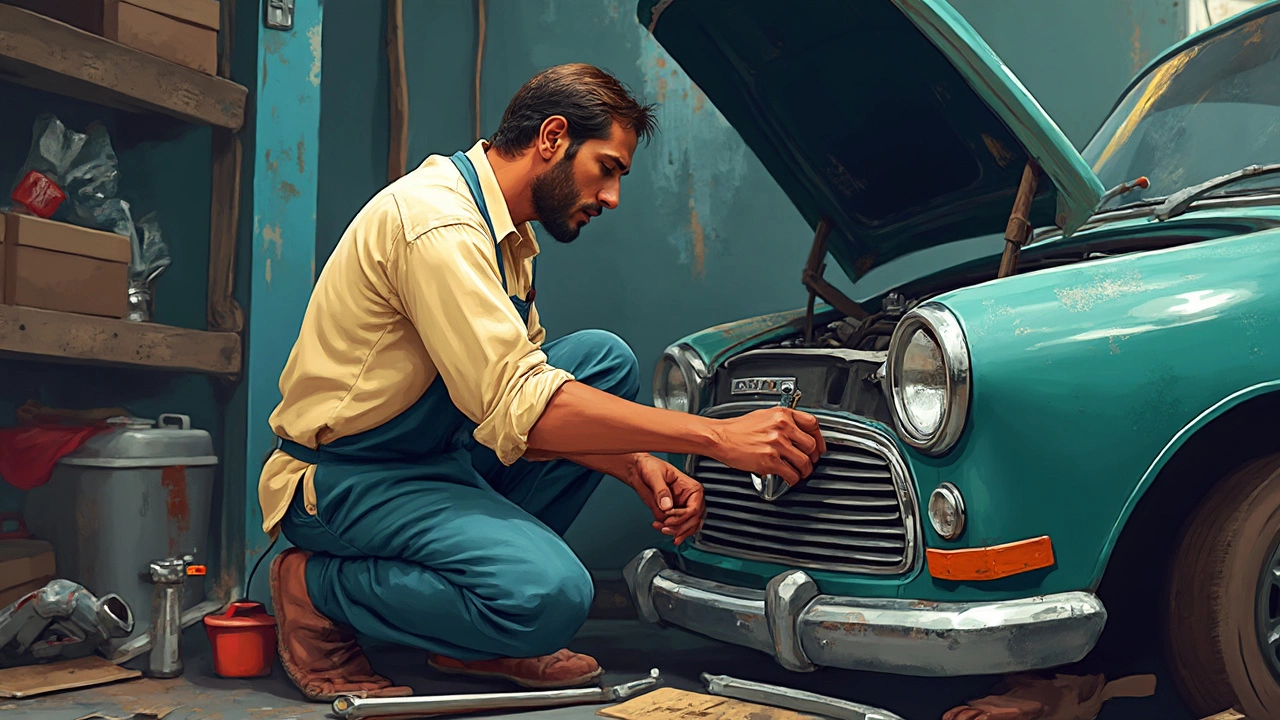 Mar, 13 2025
Mar, 13 2025
So, you're wondering if you can drive with a bad radiator? Well, picture this: your car's radiator is the unsung hero, quietly keeping your engine from turning into a smoking piece of metal. It's crucial, and when it goes bad, things can get heated—literally.
The radiator regulates your engine's temperature and prevents it from overheating. Think of it as your car's cooling fan on a hot summer's day, working tirelessly to keep things from boiling over. If your radiator's not pulling its weight, your car could be in hot water (no pun intended). Your engine might overheat, leading to severe, and generally pricey, damage.
Driving with a bad radiator? Not a great move. As tempting as it might be to ignore it and hope for the best, ignoring radiator issues is like pressing your luck. Not convinced? Stick around to spot signs of trouble, and get clued up on what to do if your radiator goes rogue.
- Why Your Radiator Matters
- Signs Your Radiator Is Failing
- The Risks of Driving with a Bad Radiator
- Emergency Measures: What to Do If Your Radiator Fails
- Repair vs. Replacement: Making the Right Choice
- Preventive Tips to Avoid Radiator Trouble
Why Your Radiator Matters
The radiator is like your car's trusty sidekick in the ongoing battle against engine heat. It plays a starring role in keeping your ride cool and running smoothly, without which your engine might just throw a tantrum and overheat. Radiator problems are not something you can just wave away.
Car radiators do more than just sit there looking pretty. They're both a protector and a supporter. Let me break it down:
- Heat Dissipation: The radiator's main gig is to dissipate the engine heat that builds up when you're driving. Without it, your engine would quickly become a baking oven.
- Coolant Circulation: Think of coolant as the lifeblood of your car. It circulates through the engine, absorbs heat, and then flows to the radiator where it's cooled down before taking another lap.
- Pressure Control: It also keeps the pressure in check. Too much pressure, and you could blow a gasket—literally.
It's not just about avoiding an overheated engine. A bad radiator can create a domino effect, leading to a cracked cylinder head, warped engine block, or even a ruined transmission. Nobody wants that kind of trouble.
So, whether you're cruising downtown or taking a road trip, remember that keeping your radiator in top shape ensures your car stays lively and responsive. If that's not reason enough to give it some TLC, nothing is!
Signs Your Radiator Is Failing
So, you think your radiator might be acting up? Catching issues early is key to dodging bigger headaches (and expenses!). Here’s how you can spot trouble brewing in your bad radiator.
Unusual Temperature Gauge Readings
Start by keeping an eye on that temperature gauge. If you notice it jacking up to the red zone more often than not, your car's engine is likely running hotter than it should. Frequent spikes aren’t normal and definitely a sign that your car radiator might not be doing its job.
Leaking Coolant
Seeing green, orange, or pink liquid under your car? That’s coolant, and it should stay in the radiator, not pool underneath your car. A puddle of coolant often spells trouble, indicating leaks that can lead to a bad radiator.
Rust or Discoloration
Take a peek under the hood. If you spot any rust or discoloration around your radiator, it’s usually a sign of damage caused by continuous coolant leaks. This one’s easy to miss, so don’t skip those regular checks.
Overheating Engine
This one’s a no-brainer. If your engine overheats, chances are your radiator’s waving a white flag. It struggles to keep the engine cool, which can lead to even worse problems over time.
Odd Smells and Steam
Notice any strange smells? A sweet odor usually hints at coolant leaks. And if you see steam coming from the hood, pull over immediately—it’s often a result of an overheating engine, tied back to the radiator.
If you notice any of these warning signs, it’s time to act. Get your radiator checked out, and don’t wait until your car’s a total hot mess. Your wallet will thank you later.
The Risks of Driving with a Bad Radiator
Driving with a bad radiator? You might as well be playing a high-stakes game of bingo with your wallet. Here's why.
Engine Overheating
Your radiator's main job is to keep your engine cool. If it fails, your engine could overheat. Imagine the mess—and the cost—to replace or repair an overheated engine. It's not pretty and can lead to massive headaches, not to mention that it could leave you stranded someplace inconvenient.
Engine Damage
Consistently driving with an overheating engine isn't just risky—it's asking for engine damage. In the worst-case scenario, you could warp your engine's cylinder heads or blow a head gasket. Either way, you're looking at expensive repairs or even a replacement.
Increased Repair Costs
A bad radiator might seem like a minor inconvenience, but ignoring it could turn a simple repair job into a bank-breaking repair bill. Small problems escalate. A complete drive-train overhaul isn't cheap and could ultimately cost more than preventive measures.
Poor Fuel Efficiency
An overheating engine won't just hurt your car; it'll also guzzle more gas. With the engine fighting for the right temperature, fuel efficiency takes a nosedive, meaning more frequent trips to the pump and more money down the drain.
Potential Safety Hazards
Let's not forget safety. Overheating can leave you high and dry on a busy road or at night, risking your safety. Equally, your ride might seize up at a critical moment, leading to dangerous situations. That's not the kind of excitement you're looking for on the road.
In essence, dealing with radiator issues promptly can save you a world of trouble. If your car is steaming and sputtering, listen to it—your bank account will thank you!

Emergency Measures: What to Do If Your Radiator Fails
So, you've realized your radiator isn't in top shape and you suspect it's failing on the go. Don’t panic. First things first, pull over safely. Driving with a compromised car radiator can push your engine to its limits.
Steps to Take Right Away
- Pull Over Safely: Get your vehicle off the road as soon as possible to avoid any further damage.
- Let It Cool: Don’t pop the hood immediately. Your engine's probably hotter than your morning coffee, so give it at least 15-30 minutes to cool down.
- Check the Temperature Gauge: When it's safe, check your car's temperature gauge to confirm it's cooled.
- Inspect for Leaks: Look for puddles under your car indicating leaking coolant. It could be a blown hose or the radiator itself.
What to Do Next
If you're not seeing immediate leaks, try topping up the coolant as a temporary measure. Use water if coolant isn't available, just to get to a service station safely. But remember, this is NOT a permanent fix.
Call for Help
Time to call in the cavalry—or a tow truck. It's vital to get your car checked and repaired to avoid more costly issues down the road. If you're not into DIY fixes, letting a professional take the reins is wise.
Did you know overheating issues are one of the top reasons for roadside breakdowns? Take this stuff seriously! Keeping an eye on your car radiator ensures you won’t end up stuck and steamed by the side of the highway.
| Car Issue | Occurrence Rate |
|---|---|
| Radiator Problems | 20% |
| Engine Overheating | 15% |
| Flat Tires | 28% |
Bottom line, a busted radiator is more than an inconvenience—it's a potential engine killer. So, when in doubt, sit it out. Get help, get safe, and get it fixed!
Repair vs. Replacement: Making the Right Choice
Facing issues with your bad radiator and trying to decide between repairing it or going all in for a replacement? It's like choosing between a patch-up job and a complete makeover. Both options have pros and cons, so let's break it down.
When to Consider Repairs
Most folks opt for a repair when the damage is minor or mostly surface-level—think leaks from a small crack or hose issues. Repairing is often far cheaper and quicker, getting you back on the road without breaking the bank. Look for quick fixes like sealing tiny cracks with a radiator sealant or replacing damaged hoses, which are easy on the wallet.
But here's the catch: repairs are a bandaid solution. They don't offer long-term guarantees, and if your car radiator is old or prone to repetitive issues, they might not last.
Time for a Replacement?
If your radiator is as old as the hills or showing signs of extensive wear, replacement might be the wiser choice. A new radiator ensures reliable performance and is more of a one-and-done deal. You'll avoid frequent visits to the mechanic and potential overheating disasters down the road.
Replacement is a solid investment, particularly if you plan on keeping your car for a while. However, if your car's older, asking yourself if it's worth the effort and expense is a smart move.
Do The Math
Ultimately, your budget is deciding. A repair will cost significantly less upfront—but make sure to factor in possible extra costs down the line if repairs don't hold. For example:
| Option | Price Range |
|---|---|
| Repair | $50 - $200, depending on the issue |
| Replacement | $300 - $1,000, depending on your car's make and model |
Just remember: while repairs might be economical short-term, a replacement offers peace of mind.
Preventive Tips to Avoid Radiator Trouble
Keeping your car's radiator in tip-top shape doesn't require a degree in rocket science. Here are some straightforward tips to keep that engine cooling system running smoothly.
Check and Top Off Coolant
The blood of any radiator, the coolant, should always be at the right level. Regularly pop the hood and check the coolant tank. If it's low, top it up with the correct mixture of water and antifreeze. This keeps your radiator circulating the way it should.
Watch for Leaks
Spotted puddles under your car? It could be a radiator leak. Fixing small leaks early can save you from big headaches. If you’re unsure, a little soapy water around seals can help identify sneaky leaks when bubbles form.
Keep It Clean
Dirt and debris can block airflow through the grille. Give it a regular clean to ensure unrestricted air supply, or, if you're really feeling it, carefully hose down your radiator.
Inspect the Radiator Cap
Your radiator cap isn’t just a fancy lid. It maintains the system's pressure. Every now and then, make sure it's sealing tightly and in good condition.
Regular Service
A good mechanic will spot potential issues during routine servicing. Don't skip those scheduled visits—they're like doctor check-ups for your car.
Don’t Overload
Carrying too much weight can overwork your engine, which in turn stresses the radiator. So, unless you're moving house, keep it light when possible.
Last but not least, trust your instincts. If something smells hot or seems off, it's worth checking out sooner rather than later. Better safe than sorry, when it comes to avoiding radiator troubles!